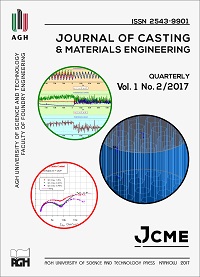The Effect of Rapid Cooling on the Corrosion Resistance of As-Cast Aluminium Alloy 5052
DOI:
https://doi.org/10.7494/jcme.2017.1.2.48Abstract
The effect of rapid cooling by the vacuum suction casting method (VSC) on the microstructure and electrochemical response of the as-cast 5052 aluminium alloy is presented. The VSC method allowed us to obtain massive samples with
a very high cooling rate (102 – 103) oC/s. The microstructure of the quick-cooled sample (QC) has been significantly changed. Finer grains and more-homogeneous intermetallic phase distribution has been observed. Corrosion potential (OCP) and polarization measurements (LSV) revealed a higher activity of the QC alloy than ingot (IN), which leads to a denser and thicker corrosion-product formation on the surface. Electrochemical Impedance Spectroscopy (EIS) indicates higher resistance values, which suggests a greater thickness of the corrosion products.
Downloads
References
ASM Handbook Volume 2: Properties and Selection: Nonferrous Alloys and Special-Purpose Materials (1990). Materials Park: ASM International.
Brown J.R. (1999). Foseco Non-Ferrous Foundryman’s Handbook. Butterworth-Heinemann.
Hollingsworth E.H., Hunsicker H.Y. (1987). Corrosion of Aluminium and Aluminium Alloys. Vol. 13, ASM Handbook. Materials Park: ASM International.
Schweitzer P.A. (2009). Fundamentals of Corrosion, Mechanisms, Causes, and Preventative Methods. Boca Raton: CRC Press.
Birbilis N.R., Buchheit G. (2005). Electrochemical characteristics of intermetallic phases in aluminum alloys. Journal of The Electrochemical Society, 152(4), B140–B151.
Suter T., Alkire R.C. (2001). Microelectrochemical Studies of Pit Initiation at Single Inclusions in Al 2024-T3. Journal of The Electrochemical Society, 148(1), B36–B42.
Krawiec H., Vignal V., Szklarz Z. (2008). Local electrochemical studies of the microstructural corrosion of AlCu4Mg1 as-cast aluminium alloy and influence of applied strain. Journal of Solid State Electrochemistry, 13, 1181–1200.
Krawiec H., Szklarz Z., Vignal V. (2012). Influence of applied strain on the microstructural corrosion of AlMg2 as-cast aluminium alloy in sodium chloride solution. Corrosion Science, 65, 387–396.
Handbook of Aluminium. Vol. 2, Corrosion of Aluminum and Its Alloys. Chapter 13 (2003).
Dorin T., Stanford N., Birbilis N., Gupta R.K. (2015). Influence of cooling rate on the microstructure and corrosion behavior of Al-Fe alloys. Corrosion Science, 100, 396–403.
Liu Y., Liu M., Luo L., Wang J., Liu Ch. (2014). The solidification behavior of AA2618 aluminum alloy and the influence of cooling rate. Materials, 7(12), 7875–7890.
Das N., Sengupta P., Abraham G., Arya A., Kain V., Dey G.K. (2016). Development in corrosion resistance by microstructural refinement in Zr-16 SS 304 alloy using suction casting technique. Materials Research Bulletin, 80, 295–302.
Sheng-yong Li, De-jiang Li, Xiao-qui Zeng, Wen-jiang Ding. (2014). Microstructure and mechanical properties of Mg- -6Gd-3Y-0.5Zr alloy processed by high-vacuum die-casting. Transactions of Nonferrous Metals Society of China, 24(12), 3769−3776.
Sheng L.Y., Zhang W., Guo J.T., Zhou L.Z., Ye H.Q. (2009). Microstructure evolution and mechanical properties’ improvement of NiAl-Cr(Mo)-Hf eutectic alloy during suction casting and subsequent HIP treatment. Intermetallics, 17(12), 1115–1119.
Perez N. (2004). Electrochemistry and Corrosion Science. Boston: Kluwer Academic Publishers.
Downloads
Published
Issue
Section
How to Cite
Accepted 2017-07-07
Published 2017-09-05


